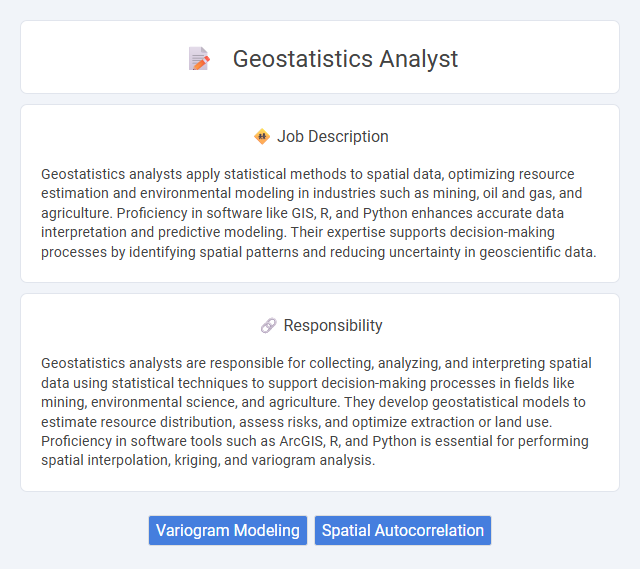
Geostatistics analysts apply statistical methods to spatial data, optimizing resource estimation and environmental modeling in industries such as mining, oil and gas, and agriculture. Proficiency in software like GIS, R, and Python enhances accurate data interpretation and predictive modeling. Their expertise supports decision-making processes by identifying spatial patterns and reducing uncertainty in geoscientific data.
Individuals with strong analytical skills and a background in mathematics or statistics are likely suitable for a Geostatistics analyst role. Those comfortable working with complex datasets and possessing attention to detail may find this job aligns well with their abilities. It is probable that individuals who enjoy problem-solving and have an interest in spatial data analysis will thrive in this position.
Qualification
A Geostatistics Analyst typically requires a strong foundation in mathematics, statistics, and spatial data analysis, often demonstrated by a bachelor's or master's degree in geostatistics, geology, environmental science, or related fields. Proficiency in GIS software, programming languages such as Python or R, and expertise in variogram modeling and kriging techniques are essential qualifications. Experience in analyzing large geospatial datasets, interpreting spatial patterns, and producing accurate predictive models is highly valued in this role.
Responsibility
Geostatistics analysts are responsible for collecting, analyzing, and interpreting spatial data using statistical techniques to support decision-making processes in fields like mining, environmental science, and agriculture. They develop geostatistical models to estimate resource distribution, assess risks, and optimize extraction or land use. Proficiency in software tools such as ArcGIS, R, and Python is essential for performing spatial interpolation, kriging, and variogram analysis.
Benefit
A Geostatistics analyst might significantly enhance resource estimation accuracy, leading to more informed decision-making in sectors like mining and environmental management. Their expertise could improve the efficiency of data interpretation, potentially reducing project costs and time. Companies may likely experience better risk assessment and optimized resource allocation through their specialized statistical modeling skills.
Challenge
Geostatistics analysts likely face challenges in managing large and complex spatial data sets requiring advanced statistical techniques. The role probably demands continuous adaptation to evolving software tools and methodologies to ensure accurate modeling and predictions. They may also need to address uncertainties inherent in spatial data and communicate findings effectively to multidisciplinary teams.
Career Advancement
Geostatistics analysts leverage spatial data to model and interpret geological patterns, providing critical insights for industries such as mining, oil and gas, and environmental science. Career advancement often involves gaining expertise in advanced statistical software, machine learning applications, and project management, leading to roles like senior analyst, data scientist, or geostatistical consultant. Professional certifications and continuous education in geospatial technologies significantly enhance prospects for leadership positions and specialized research opportunities.
Key Terms
Variogram Modeling
A Geostatistics Analyst specializing in Variogram Modeling uses spatial data to quantify spatial continuity and variability, essential for accurate resource estimation and spatial prediction. Expertise in experimental variogram calculation, model fitting, and validation supports geoscientific decision-making in mining, environmental science, and hydrogeology. Mastery of software such as GeoStat, R packages (gstat, automap), and Python libraries (scikit-learn, pykrige) enhances the quality of spatial interpolation and kriging methods.
Spatial Autocorrelation
A Geostatistics analyst specializes in interpreting spatial data by applying techniques such as spatial autocorrelation to identify patterns and relationships across geographic areas. Spatial autocorrelation metrics, like Moran's I and Geary's C, enable analysts to measure the degree of similarity between data points within a spatial context, enhancing predictive modeling accuracy. Proficiency in GIS software, statistical programming languages, and spatial data visualization tools is essential for effectively analyzing and mapping spatial dependencies in various industries.
 kuljobs.com
kuljobs.com